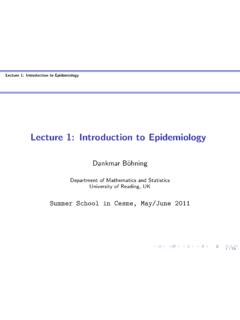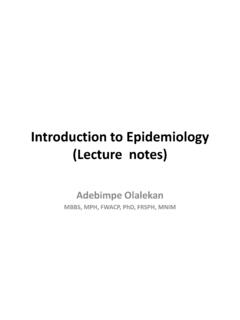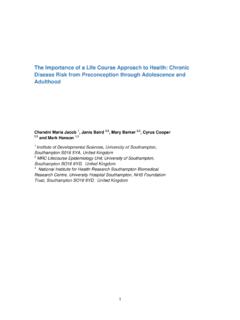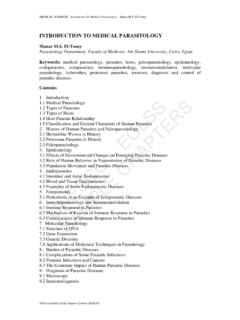Transcription of INTRODUCTION TO MEDICAL PARASITOLOGY
1 UNESCO EOLSSSAMPLE CHAPTERSMEDICAL SCIENCES - INTRODUCTION To MEDICAL PARASITOLOGY - Manar El-Tonsy Encyclopedia of Life Support Systems (EOLSS) INTRODUCTION TO MEDICAL PARASITOLOGY Manar El-Tonsy PARASITOLOGY Department, Faculty of Medicine, Ain Shams University, Cairo, Egypt. Keywords: MEDICAL PARASITOLOGY , parasites, hosts, paleoparasitology, epidemiology , endoparasites, ectoparasites, immunoparasitology, immunomodulation, molecular PARASITOLOGY , helminthes, protozoan parasites, zoonosis, diagnosis and control of parasitic diseases. Contents 1. INTRODUCTION MEDICAL PARASITOLOGY Types of Parasites Types of Hosts Host-Parasite Relationship Classification and General Characters of Human Parasites 2.
2 History of Human Parasites and Paleoparasitology Helminthic Worms in History Protozoan Parasites in History Paleoparasitology 3. epidemiology Effects of Environmental Changes on Emerging Parasitic Diseases Role of Human Behavior in Transmission of Parasitic Diseases Population Movement and Parasitic Diseases 4. Endoparasites Intestinal and Atrial Endoparasites Blood and Tissue Endoparasites Examples of Some Endoparasitic Diseases 5. Ectoparasites Pediculosis as an Example of Ectoparasitic Diseases 6. Immunoparasitology and Immunomodulation Immune Response to Parasites Mechanism of Evasion of Immune Response to Parasites Consequences of Immune Response to Parasites 7. Molecular PARASITOLOGY Structure of DNA Gene Expression Genetic Diversity Applications of Molecular Techniques in PARASITOLOGY 8.
3 Burden of Parasitic Diseases Complications of Some Parasitic Infections Parasitic Infections and Cancers The Economic Impact of Human Parasitic Diseases 9. Diagnosis of Parasitic Diseases Microscopy Immunodiagnosis UNESCO EOLSSSAMPLE CHAPTERSMEDICAL SCIENCES - INTRODUCTION To MEDICAL PARASITOLOGY - Manar El-Tonsy Encyclopedia of Life Support Systems (EOLSS) Molecular-Based Approaches Imaging Techniques and Endoscopy Recent Diagnostic Advances Using Nanotechnology 10. Control of Parasitic Diseases Methods of Prevention and Control of Food and Water Borne Parasitic Diseases Control of Vector Borne Parasitic Diseases Control of Neglected Tropical Parasitic Diseases Acknowledgment Glossary Bibliography Biographical Sketch Summary MEDICAL PARASITOLOGY is the branch of MEDICAL sciences dealing with organisms (parasites) which live temporarily or permanently, on or within the human body (host).
4 There are different types of parasites and hosts. The competition for supremacy that takes place between the host and the parasite is referred to as host-parasite relationship. Accordingly, the host may have the upper hand and remains healthy or loses the competition, and a disease develops. Human parasites are either unicellular (protozoa) or multicellular (helminthes and arthropods). The parasites may live inside the host (endoparasites) or on the host surface (ectoparasites). Endoparasites are classified into intestinal, atrial or they may inhabit body tissues causing serious health problems. Ectoparasites are arthropods that either cause diseases, or act as vectors transmitting other parasites.
5 Human evolution and parasitic infections have run hand in hand and most parasitic diseases and methods of their transmission have been discovered thousands of years ago. Environmental changes, human behavior and population movement have a great effect on transmission, distribution, prevalence, and incidence of parasitic diseases in a community. Parasites can invade the human body in different ways; through oral route, skin, arthropod vectors or sexual contact. Host defense mechanisms consist of innate immunity which mediates initial protection against infection and adaptive immunity which is more effective. Once parasites have evaded innate host defenses, adaptive cellular and humoral immune responses are promoted against a wide array of antigenic constituents.
6 Diagnosis of parasitic diseases depends on several laboratory methods, imaging techniques and endoscopy in addition to clinical picture and geographic location. Parasitic diseases may be presented by a wide variety of clinical manifestations according to the tissue invaded. Direct microscopy is based on detection of the parasite by examination of different specimens (stool, urine, blood, CSF and tissue biopsies). Immunodiagnostic techniques include antigen and antibody-detection assays. Molecular-based diagnostic approaches offer great sensitivity and specificity. Recently, nanotechnology can be applied as diagnostic procedures utilizing nanodevices. Control and prevention of parasitic diseases depend on the interactions among many factors such as the environment, the human behavior, and socio-cultural factors that determine transmission and persistence of parasites.
7 UNESCO EOLSSSAMPLE CHAPTERSMEDICAL SCIENCES - INTRODUCTION To MEDICAL PARASITOLOGY - Manar El-Tonsy Encyclopedia of Life Support Systems (EOLSS) 1. INTRODUCTION MEDICAL PARASITOLOGY is the science dealing with parasites that infect man, causing disease and misery in most countries of the tropics. They plague billions of people, kill millions annually, and inflict debilitating injuries such as blindness and disfiguration on additional millions. World Health Organization estimates that one person in every four harbors parasitic worms. The present work aims to clarify several aspects concerning parasites of MEDICAL importance to man. Parasite classification, general characters, biology, ecological factors that affect their transmission, the immune response of the body to invading parasites, diagnosis and control of the disease developed are highlighted.
8 MEDICAL PARASITOLOGY MEDICAL PARASITOLOGY is the branch of MEDICAL sciences dealing with organisms (parasites) which live temporarily or permanently, on or within the human body (host). PARASITOLOGY is a dynamic field because the relationships between parasites and their hosts are constantly changing. Parasitism comprises an ecological relationship between two individuals of different species where the parasite s environment is another living organism. Parasites often cause important diseases of humans and animals (Bogitsh et al., 2005). For this reason, PARASITOLOGY is an active field of study in which advances in biotechnology have raised expectations for the development of new drugs, vaccines, and other control measures.
9 However, these expectations are dampened by the inherent complexity of parasites and host-parasite relationships, the entrenchment of parasites and vectors in their environments, and the vast socioeconomic problems in the geographical areas where parasites are most prevalent (McGraw-Hill, 2005). But what is the parasite? The parasite is a living organism that lives in (endoparasite) or on (ectoparasite) another organism, termed its host. It obtains nourishment and protection while offering no benefit in return. Consequently, the host suffers from various diseases, infections, and discomforts. However, in some cases, the host may show no signs at all of infection by the parasite (UXL Encyclopedia of Science, 2002).
10 Types of Parasites According to the nature of the host-parasite interactions and the environmental factors, the parasite may be one of the following types; An obligatory parasite that is completely dependent on its host and can t survive without it hookworms. A facultative parasite that can change its life style between free-living in the environment and parasitic according to the surrounding conditions. Strongyloides stercoralis. An accidental parasite that affects an unusual host Toxocara canis (a dog parasite) in man. A temporary parasite that visits the host only for feeding and then leaves it. Bed bug visiting man for a blood meal. UNESCO EOLSSSAMPLE CHAPTERSMEDICAL SCIENCES - INTRODUCTION To MEDICAL PARASITOLOGY - Manar El-Tonsy Encyclopedia of Life Support Systems (EOLSS) A permanent parasite that lives in or on its host without leaving it Lice.
















